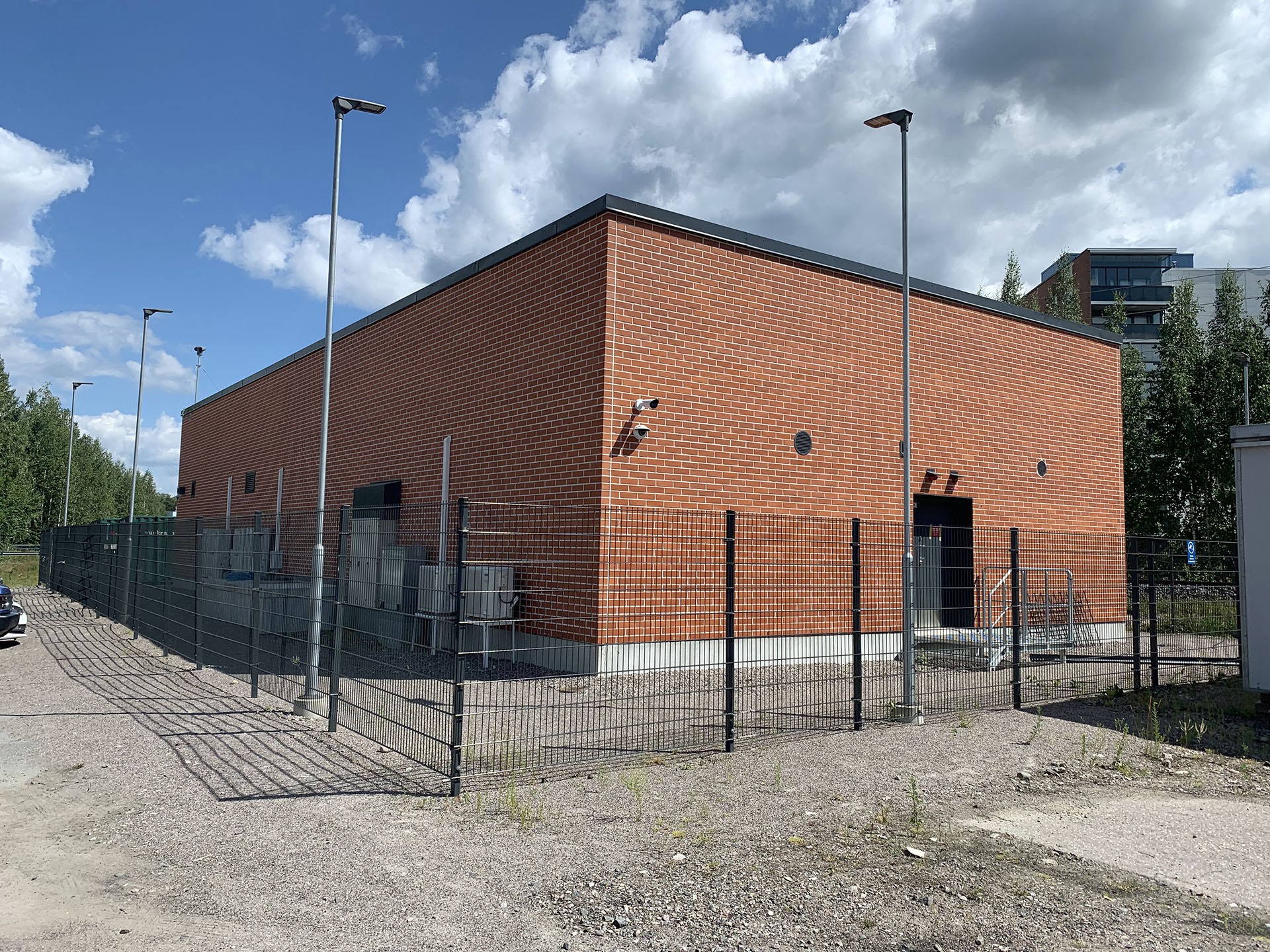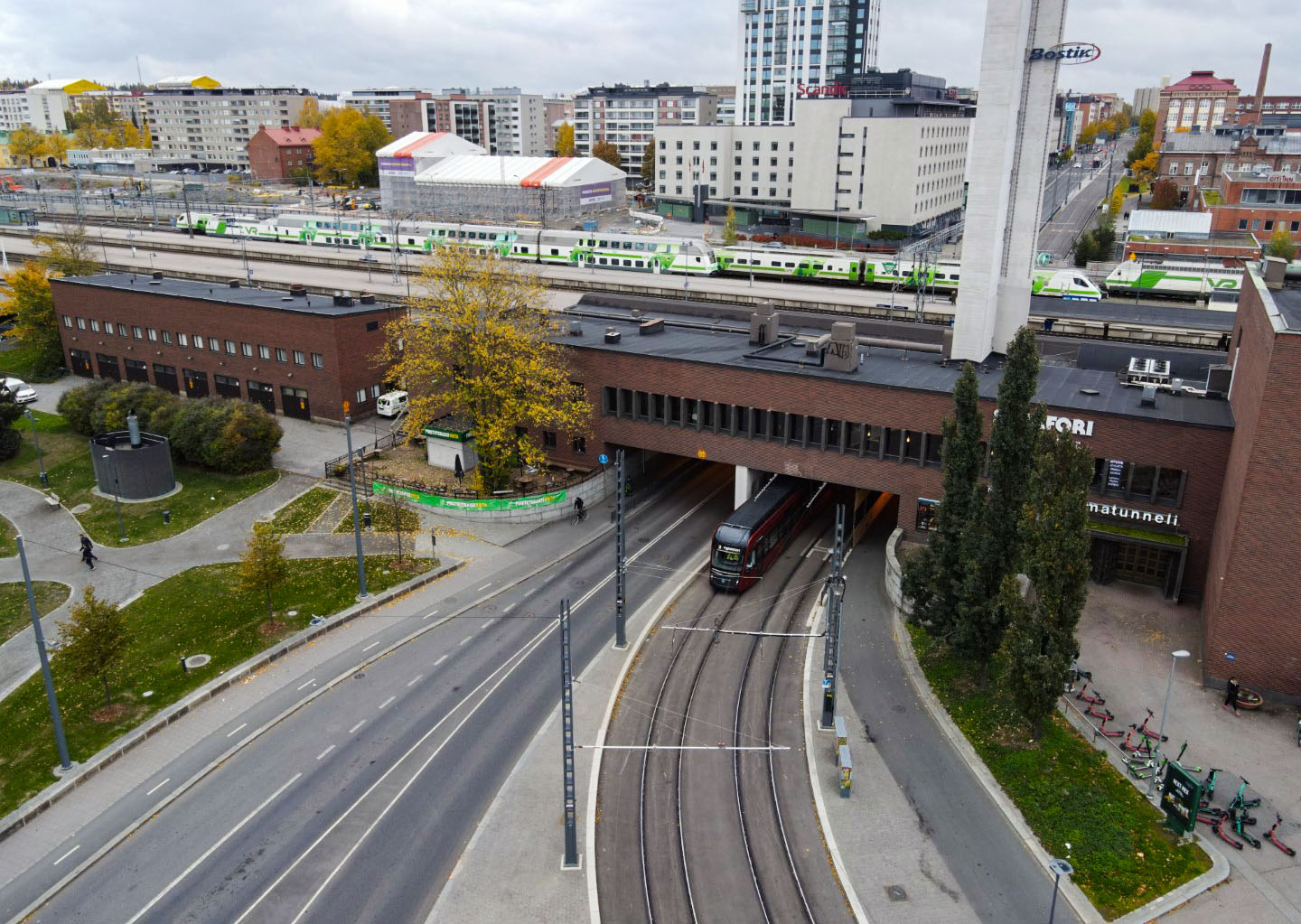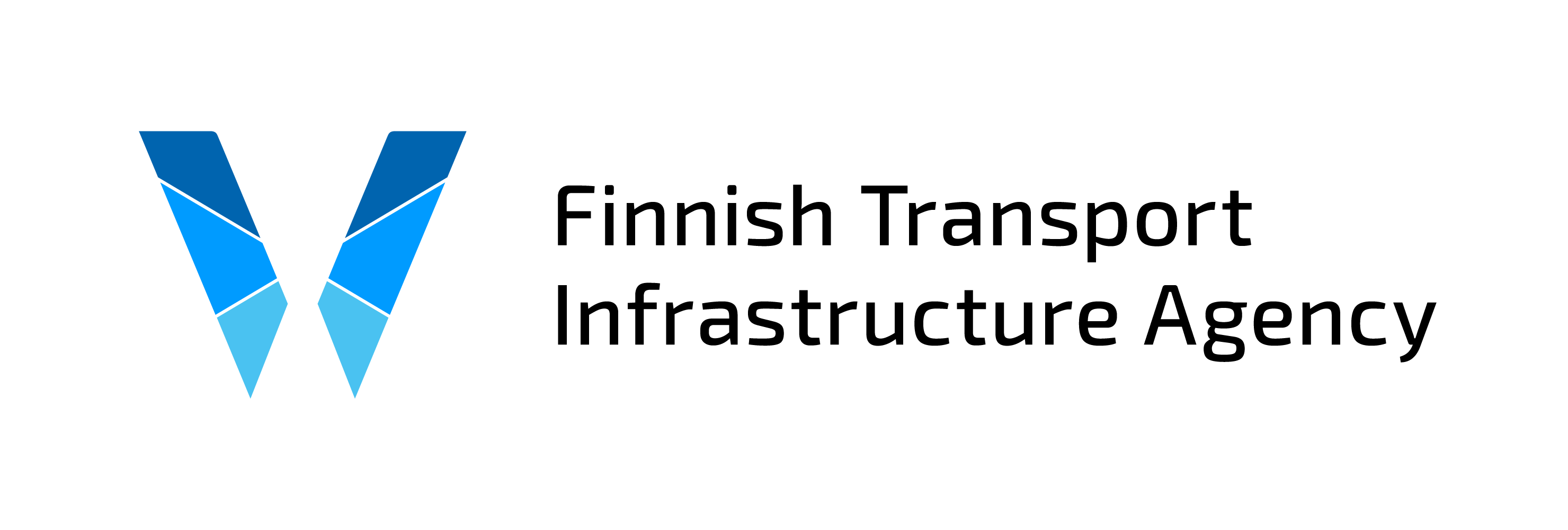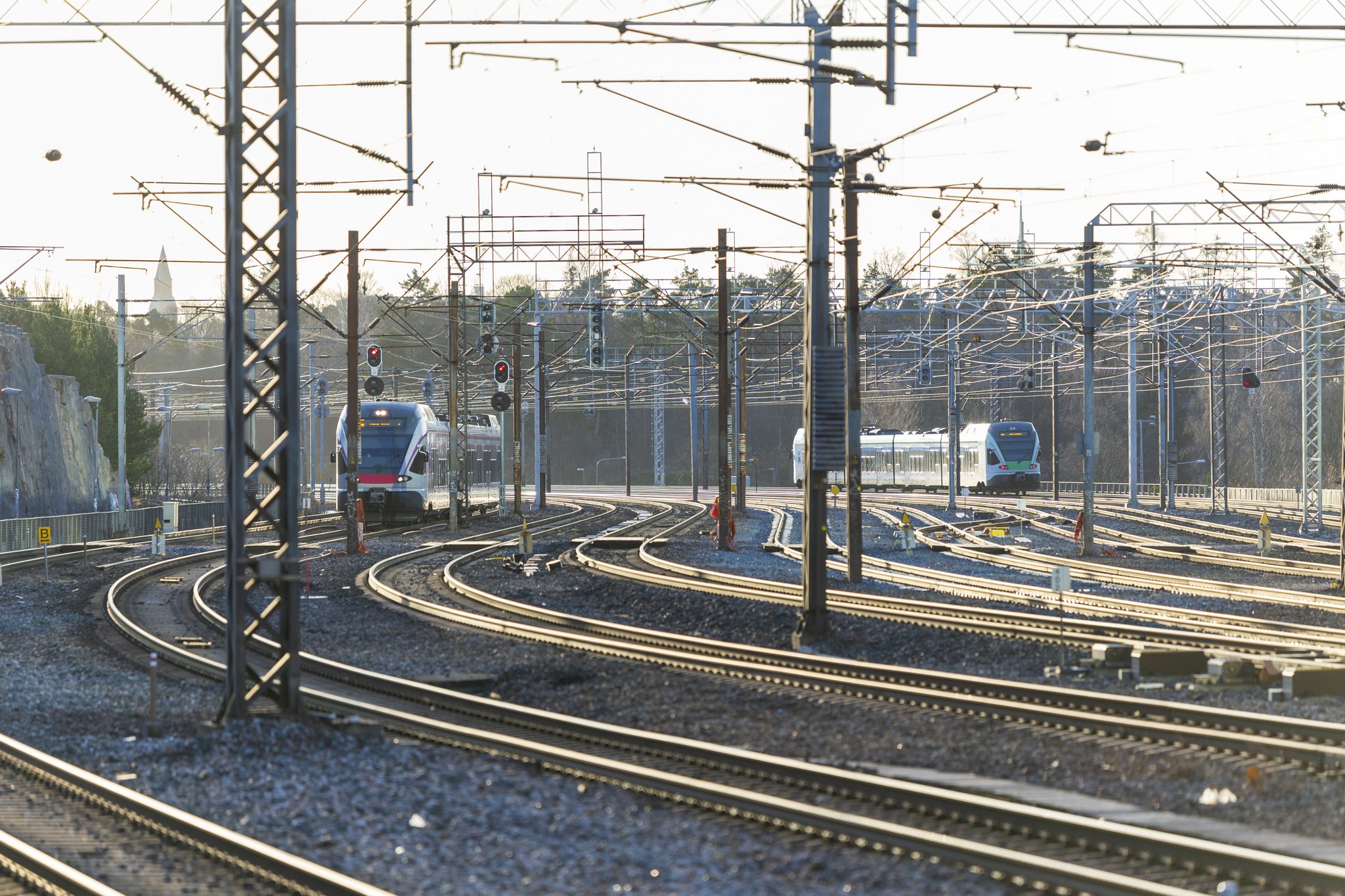The main line’s starting points were built over 160 years ago, making it the oldest railway line in Finland. Growing traffic volumes have increased the need to develop the railway line. During the past ten years, the route has been developed at both ends. The development continues and is still necessary, as the main line is of great significance for both passenger and freight train traffic.
Go on a trip on the main line and see how it has changed and is changing.
Departing from Helsinki
The journey from south to north on the main line starts from the Helsinki railway station where a project that improved the functionality of the railway yard was completed at the end of last year, with the exception of some finishing and demolition works. The project to improve the functionality and efficiency of Helsinki railway yard achieved its objectives, and the railway yard’s vulnerability to disruptions has decreased and its train capacity has been increased by approximately 16 trains, that is, from 74 trains to nearly 90 trains per hour.
“The purpose of the project was to increase capacity and reduce the line’s vulnerability to disruptions, and these objectives were achieved through good planning and successful cooperation. We prepared for future challenges in the improvement of the main line, which means that now there is more room for manoeuvre in exceptional circumstances,” says Project Manager Veli-Matti Kantamaa from the Finnish Transport Infrastructure Agency.
The Helsinki railway yard could not be expanded in the project due to lack of space, so the existing railway yard was developed to improve functionality and increase capacity. Turnouts and junction lines were added to the railway yard in the project, which led to an increase in track options in train traffic between Helsinki and Pasila. In addition, signal intervals were reduced by adding block signalling between the Helsinki–Pasila section, which means securing the safe travel of consecutive trains with automation. This makes it possible to considerably increase the capacity of the railway line. The relay group interlocking in Helsinki enables these types of additions with reasonable ease.
“In the railway yard, automatic train control was improved by introducing the Ebiloop system that adds flexibility to the ATP system, that is, to train control, and also enables capacity increases,” Kantamaa clarifies.

Kerava's new interlocking.
In total, approximately 20 turnouts were installed during the project’s construction phase between 2016 and 2019. At the same time, the signalling equipment changes required by the turnouts were made to the existing interlocking, and the superstructures of the service tracks were refurbished. In addition, track changes, signalling equipment upgrades and catenary system alterations related to the additional western track in Pasila were carried out during the project.
The project’s costs ended up totalling 50 million euros, which was about 10 million euros less than what was recorded in the cost estimate. The construction planning received funding from the TENT-T scheme.
Pasila affects the whole country
Completing the project to improve the functionality and efficiency of Helsinki railway yard was an important part of preparing for the increasing traffic volumes on the Pasila–Riihimäki line and the Espoo City Rail Link. The work at the Helsinki railway yard had to be coordinated with the on-going train traffic. Construction work at Mall of Tripla and the construction of the additional track in Pasila brought their own challenges.
The additional western track in Pasila, which was completed two years ago, significantly improves traffic on the main line. The 1.5 km section consists of a new track and station platform.
More than a thousand trains pass through Pasila on weekdays, which makes the station critical for the efficient running of train traffic throughout the country. Constructing an additional track therefore contributes both to the reduction of disruptions in freight traffic and to the punctuality of passenger trains.
Many improvements between Tikkurila and Riihimäki
The journey on the main line continues northward to Tampere. The line goes through the ongoing Helsinki–Riihimäki project, the aim of which is to increase capacity and reduce the line’s vulnerability to disruptions.
The project consists of three different phases, the end goal of which is to have at least four tracks along the whole Helsinki–Riihimäki line section. This will improve the reliability of the main line, allow an increase in the number of passenger trains and improve the competitiveness of freight traffic.
The first phase focused in particular on improving traffic operating points. Construction work was carried out at the Tikkurila, Kerava, Järvenpää and Riihimäki stations, among other places. Work in Tikkurila still continues. In the project’s second and third phase, the actual additional track sections will be built, which ultimately makes it possible to increase the number of passenger trains.
“The first phase of the project, which began in 2015, focused on improving traffic operating points, as it achieved the most benefits. Without any changes, the traffic operating points would have become ‘bottlenecks’ in terms of capacity once the additional tracks built at later phases had been completed,” explains Project Manager Riitta Parviainen from the Finnish Transport Infrastructure Agency.
The project’s first and second phase are in the construction phase. In the second phase, additional tracks will be built between Kerava and Jokela.
Good things come in threes
In the project’s third phase, which is now in the planning phase, the aim is to build additional tracks from Jokela to Riihimäki.
“The improved throughput capacity enables four hourly commuter trains in each direction between Helsinki and Riihimäki, whereas there are currently two trains in each direction. The additional tracks also make it possible to speed up commuter trains between Helsinki and Riihimäki, as it is possible to schedule bypasses between long-distance trains and commuter trains without slowing down commuter trains. Once commuter trains and long-distance trains have been transferred to their own tracks, the travel times of long-distance trains can also be reduced,” explains Project Manager Marketta Ruutiainen from the Finnish Transport Infrastructure Agency.
The project will also make the line more resilient to disruptions, making traffic more streamlined and reliable.
The railway plan for the Helsinki–Riihimäki railway project’s phase three will be approved in 2023, but a decision on construction has not yet been made.
Major changes coming to the Tampere passenger railway yard
With a total of about 2.7 million departing, arriving and transferring passengers each year, the Tampere station is among the busiest stations on the main line. A total of about 170 passenger and freight trains travel through Tampere every day. The aim of the Finnish Transport Infrastructure Agency is to revamp the station in the Tampere passenger railway yard project. The goal of the project, which is currently in the planning phase, is to build a new passenger traffic platform and better access routes for train passengers throughout the station area in Tampere.

“Tampere is a hub in the Finnish train traffic network, and the functions of the Tampere passenger railway yard are used by both passenger and freight train traffic on the national level. This is why the Tampere passenger railway yard project is crucial for the entire country’s train traffic and the main line,” explains Project Manager Mikko Heiskanen from the Finnish Transport Infrastructure Agency.
The Tampere passenger railway yard project is part of a larger programme, the aim of which is to improve the use and functionality of the main line.
“This programme is linked to the surrounding development and renovation needs, such as the Tampere–Helsinki projects, the Tampere–Jyväskylä line’s construction project, the Tampere–Pori level crossing removal project and the possible Digirail test section towards Pori simultaneously with the construction of the railway yard itself,” Heiskanen clarifies.
The project, which has a cost estimate of approximately 170 million euros, will also replace the train platform shelters and reorganise the maintenance systems for passenger trains. In addition, the railway line’s structures will be upgraded as required by the changes. Signalling equipment and catenary system upgrades are also part of the project.
“The project’s work carried out on the line section impacts traffic on the main line in many ways. The capacity, punctuality and accessibility of passenger traffic in the railway network will be improved. National train traffic can be provided with high-quality services. The new track arrangements will speed up passenger trains, and the track capacity of passenger traffic will increase. Shortening commuter train intervals becomes possible, and long-distance and freight traffic will also benefit from new additional tracks,” Heiskanen adds.
The project is not yet in the construction phase.
Suomirata strives for a faster journey on the main line
While the Finnish Transport Infrastructure Agency maintains the operation of the main line now and in the future, the aim of the company behind Suomirata, Finnish Rail Ltd, is to achieve a fast train connection of about one hour from Tampere to Helsinki. The railway line would run by Helsinki Airport. There are two alternatives for the implementation of the Suomirata line, one of which would mean the construction of a completely new railway line and the other the construction of additional tracks and adjustments for the existing railway line.
In September, Finnish Rail Ltd published a report on how speed could be increased on the main line between Tampere and Helsinki. According to the plan, a new alignment for a high-speed railway line would be the best alternative. If implemented, additional tracks and adjustments would be built on the main line. The Suomirata project is not the Finnish Transport Infrastructure Agency’s project.
Fact box
- The idea of the main line first emerged in 1849, but it took another twenty years before the first actual train travelled the line in January 1862.
- The maintenance and construction of the line are essential, as, while half of Finns live along the main line, it is also very important for the Finnish economy.

